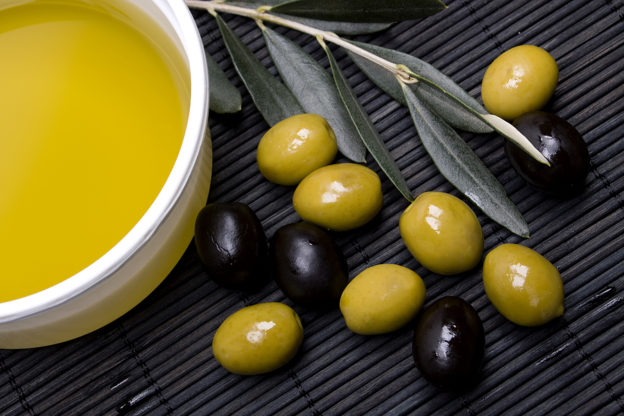By David Blyweiss, M.D., Advanced Natural Wellness
June 25, 2021
In my house, extra virgin olive oil is a mainstay. So are olives, when I remember to buy them.
As nutritional foods, they both have their pros and cons.
Obviously olives are going to have more fiber in them. They have the fiber, plus all of the oil that is contained within the fiber. That’s where you get the olive oil. It’s not as concentrated as it is in extra virgin olive oil, but that fiber is great for your gut bacteria.
My favorite olives are the Castelvetrano’s. They are nice and meaty – not too soft, not too hard, and not so salty. I like to eat a dozen or so each day, as part of a side dish at lunch or dinner, or as a snack. I also like garlic stuffed olives for added benefit.
Now Castelvetrano olives are green. Stuffed olives are generally green, too. But just because I like them the best, it doesn’t mean I don’t enjoy black olives on occasion.
Open your arteries, improve blood flow for a new health miracle...
Did you know your circulatory system has over 60,000 miles of arteries, veins and other blood vessels, if stretched end to end?
But as you age, your blood vessels undergo changes, which may cause them to stiffen, thicken and get clogged.
GOOD NEWS! Doctors have now identified a “Miracle Molecule” inside your arteries that helps OPEN your arteries and IMPROVE blood flow.
It’s what Dr. Valentin Fuster calls it, "One of the most important discoveries in the history of cardiovascular medicine."To you, that means...
- Healthy blood pressure
- Sharper mind and memory
- Skyrocketing energy and muscular strength
- Increased pleasure and passion in the bedroom
- Improved circulation to every cell and organ in your body
Go here to discover a new natural way to significantly boost the levels of this miracle molecule in YOUR body NOW!
The biggest difference between the two is their level of ripeness when picked.
Green olives are picked before they are ripe. Black olives, with the exception of canned “ripe black olives”, are picked closer to maturity. Both of them go through fermentation processes. Otherwise, they would be so hard and bitter you wouldn’t be able to eat them.
California black olives are an entirely different story. Oddly enough, the ones you see in the grocery store labeled “Ripe Black Olives” aren’t black when they’re picked. They aren’t ripe, either. They go through a treatment that oxidizes them, which turns them black.
So is there any difference between green and black olives?
Yes!
As darker olives ripen, the polyphenols in them break down. As a result, they will have a somewhat lower nutritional profile. Green olives, on the other hand, will have a higher sodium content.
The important thing to know that both black and green olives are functional foods. This means they have health benefits that extend well beyond their nutritional profile. For example, the high content of antioxidant polyphenols and vitamin E found in olives have both anti-inflammatory and anti-cancer properties. This means they are protective against inflammatory health conditions and cancer activity.
The World's Quickest Solution for Ending Prostate and Urinary Misery
This has recently been revealed to be one of the only real breakthroughs in prostate health.
The seeds of a strange fruit (sometimes called "Chinese Apples") hold powerful phytonutrients that are a revolution in prostate health.
In fact, UCLA and Veterans Administration research have now proved this to be true.
Not only that, but it may be the worlds quickest solution for ending prostate misery.
Simply stated, these phytonutrients represent a huge step beyond beta sitosterol, saw palmetto, and other phytosterols alone.
Simply click HERE if you want to have fast prostate relief...restful, uninterrupted sleep...no more constant "urges to go"...enhanced virility...and optimal prostate support for life.
Put them in your salads, eat them as a snack, stir them into hummus – pair them with your bloody Mary or martini.
One word of caution. If you buy your olives from an olive bar, you won’t be able to tell how much sodium is in them. So if you’re on a sodium-restricted diet, it’s better to stick with jarred olives where you can see the sodium content on the nutrition label.
How is Extra Virgin Olive Oil Different?
Extra virgin olive oil is loaded with the same polyphenols as olives, but in higher quantity. That’s because both green and black olives lose polyphenols during the fermentation and curing process, with the black olives containing the least.
Because olive oil doesn’t go through these processes, it also has practically no sodium in it. That’s another big plus for extra virgin olive oil.
The only thing missing is the fiber. It’s a trade-off. But you shouldn’t have to make the trade. If you like olives, enjoy them. Then, just use extra virgin olive oil in salad dressings, marinades, as a veggie drizzle and in your sauces and dips.
Not only will you get the benefits of the oil, it can also help boost the nutrient profile of the foods you’re combining it with.
The only olive oil I buy is organic cold-pressed extra virgin olive oil. But if you’ve ever browsed the olive oil shelves at the store, you know how confusing it can be to choose one.
They all sound great, so which one should you buy?
How to Select High Quality Extra Virgin Olive Oil
The first thing to be aware of is that sometimes there is dodgy information on some of those labels.
Some products labeled as “Italian extra virgin olive oil” or “Product of Italy” or “Packaged in Italy” are not actually from Italy, and might not even be 100% olive oil. Just because it says it’s from Italy, it doesn’t mean that’s where the oil came from. That could just be where it was packaged. The oil could have come from anywhere. And it’s probably low quality.
Usually, the price will tip you off, because it will be much lower than others.
Look at the label to find out exactly where the olive oil was produced. If you can’t find it, it’s best to pass it up.
What else should you look for?
- A good quality brand will have a “harvested date” or “batch date” on the label. This isn’t the same thing as the expiration date, but it will tell you how old it is. You don’t want anything older than a year.
- Light is olive oil’s enemy. Exposure to light makes the oil turn bad. So the bottle should be a dark color, and should be made of glass or metal. Never buy it in a clear or plastic bottle. Also, it’s best to by small cans or bottles that you can use quickly.
- Always choose “extra virgin olive oil” over ones that are labeled “olive oil” or “light olive oil”.
- Of course, the ultimate test is the taste and smell. If you get home and find that it’s “off”, in any way, return it and find a higher quality extra virgin olive oil.
If you’re serious about finding the absolute best extra virgin olive oil you can buy, you can check out the 2021 winners of the New York International Olive Oil Competition here.
SOURCES:
Rocha J, Borges N, Pinho O. Table olives and health: a review. J Nutr Sci. 2020;9:e57.







